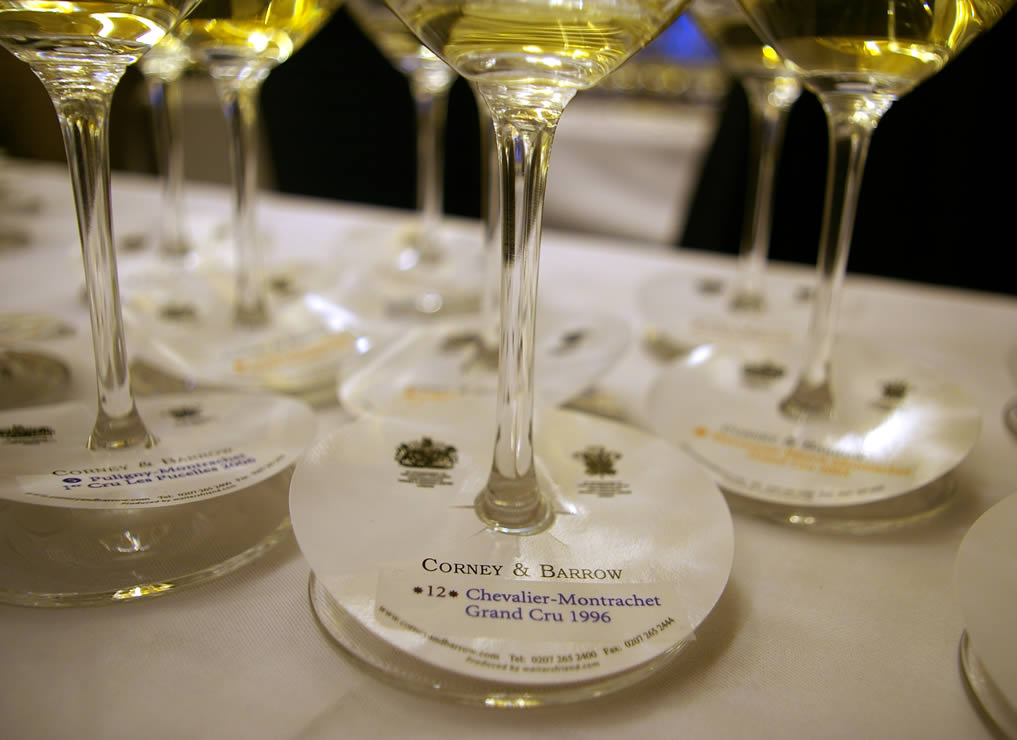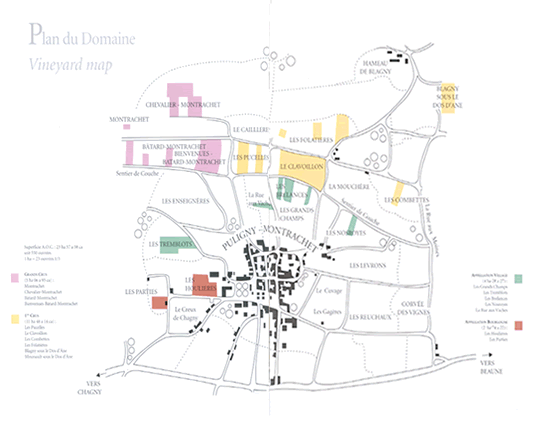
|
The wines of
Domaine
Leflaive, Puligny-Montrachet, Burgundy Place des Marronniers, 21190 Puligny Montrachet, France
A
Corney & Barrow Domaine Leflaive masterclass, with
Anne-Claude Leflaive Domaine
Leflaive needs little introduction to wine lovers. It has been
described as Burgundy’s greatest white wine domaine, and while this
is a pretty strong claim, it is a justifiable one. It’s a family
estate that was initially created by Anne-Claude’s grandfather
Joseph, who was born in Puligny-Montrachet but left to become an
engineer. At one stage he had a factory in St Etienne and was part of
the team that made the first French submarine, but things went badly
and bankruptcy followed. Not
deterred by this misfortune, he returned to Puligny-Montrachet in
1905. This was just after the phylloxera crisis, and so land was
pretty cheap. ‘No one believed any more in the vines’, says
Anne-Claude, ‘so he bought 25 hectares for virtually nothing.’
Joseph certainly believed, though: he thought that these vines had
value, and set about building the domaine. Of his five children, four,
including Anne-Claude’s father Vincent, became involved in the
domaine. After Joseph died in 1953, Vincent along with his brother Jo
were responsible for its development. Together, they established the
reputation of the domaine as one of the best in Burgundy. In
1990, Joseph was 90, and it was time for the next generation to take
the reins. Anne-Claude and her cousin Olivier Leflaive took over from
Joseph, and this arrangement continued for four years. However,
Olivier was also running a negociant business, and in 1994 the
shareholders (made up of some 30 family members) decided they wanted
just one person running things – Anne-Claude – and so the
businesses were separated. ‘I was a hard task for me’, she
recalls, ‘but also a challenge’. She decided to change the way the
vines were cultivated, moving to a more natural approach. ‘I asked
the people who had been working there for 25 years to change the way
they worked: forget weedkiller, fertilizer and phytosanitary products.
I thought it was important to put the soil in good health, and I was
convinced that something should change, but I didn’t know what’. ‘I
think that in your life, if you really want something, heaven helps
you and you find people in front of you to help you’, says
Anne-Claude, rather philosophically. It was at this stage she met
biodynamic consultant François Brochet and soil expert Claude
Bourguignon, both of whom would lead her towards the biodynamic wine
growing that she now practices. For
several years Anne-Claude experimented, doing direct comparisons
between biodynamics and organics on the same blocks of vines. Together
with her right-hand man Pierre Morey and the rest of the team, the
final decision was taken to shift all viticulture to biodynamics in
1997. ‘I didn’t want to just take the decision myself,’ she
recalls. ‘I asked the team to make the decision, and fortunately
they decided to go for biodynamics. They saw it was better for the
soil, the health of the vines and the wines. For seven years we had
tasted the wines blind and most of the time the biodynamic wines
showed more complexity and purity’. It
was a brave choice. As Adam Brett-Smith of her UK importers Corney
& Barrow puts it, ‘It took tremendous courage to make
revolutionary changes at a domaine basking in the adulation of the
world. A lot of people were waiting for her to fail, but she has taken
this domaine to impossibly high levels’. Brett-Smith continues his
eulogy by adding, ‘Anne Claude is the daughter of a legend who took
over and became a legend herself.’ Biodynamics
proved to be particularly effective in 2004, a difficult vintage for
most growers. ‘It was wet and cold, which was very good for oidium
[a fungal disease], which was present everywhere,’ recalls
Anne-Claude. ‘Biodynamics helped our harvest in 2004 to be
incredibly healthy. I was shocked by the health of the grapes around
us: most were black, attacked by oidium, especially for the
winegrowers still working with chemicals.’ It
also helped with the vines in their plot in Bienvenues-Bâtard-Montrachet.
In 1990 the then 30 year old vines were in bad health, and they were
advised to replant. The leaves were chlorotic and the wood was small;
the vines had been yielding badly. The new team of Pierre Morey and
Anne-Claude decided to do an experiment on these ‘lost’ vines.
They stopped using herbicides, opened up the soil and employed the
biodynamic preparations. ‘We were the first to be astonished by the
response of the vines to the new treatment’, she recalls. ‘Now
these vines are the oldest of the domaine, over 50 years old’. Domaine
Leflaive is about to enter a new era. Pierre Morey will be retiring in
July 2008, and his replacement, who has already been working at the
domaine for the last five years, knows about red wines. Anne-Claude
revealed that she’s now going to be making some reds from Domaine
Leflaive, although she didn’t want to elaborate on the specifics.
‘It’s much more interesting to vinify red wine than white wine’,
she adds. So,
to the wines. We began by comparing two vintages: 2003 and 2006. Both
were disappointing, to be honest. The 2003s were fat and lacking real
definition: while they weren’t bad wines, they’re certainly not
cheap, and this style of wine isn’t what you come to white Burgundy
for. ‘2003 could have been sweet and soft, with a lack of energy,
but it is not’, maintains Anne-Claude, talking about what she
describes as an ‘incredibly atypical vintage’. She was sailing
south of Corsica when Pierre Morey phoned her on the 16th of August,
to tell her to come back because everyone was picking. She got back
and they tasted the grapes, deciding that they weren’t ready. They
held out until the new moon at the end of the month, which they
expected to bring a change in the weather. It did, and a little rain
came – the grapes tasted good, so they picked. Just a small quantity
of grapes were harvested, with yields down at 25 hectolitres/hectare. 2006
was also a tricky vintage, with a cold August but then a sunny
September. There was some botrytis, but September’s good weather
helped avoid this. The maturity came quickly, and remarkably the Grand
Cru vineyards were harvested first. ‘We had to do this to keep the
minerality of the Grand Crus’, says Anne-Claude. Then
we tried the 2004s, which were a real step up. ‘2004 is a vintage
with intensity, vitality and energy’, maintains Anne-Claude. ‘It
will age better than 2005’. It was tricky viticulturally, with a
real risk of oidium, but the domaine’s viticultural regime, as
mentioned above, helped preserve the health of the grapes. These wines
are showing a bit of reduction now, and Anne-Claude speculates that
this might be a consequence of the vine stress in the previous
vintage, the atypically hot 2003. Finally, there were a couple of
treats – a pair of older wines. Domaine
Leflaive Bourgogne Blanc 2003 Domaine
Leflaive Puligny-Montrachet 1er Cru Le Clavoillon 2003 Domaine
Leflaive Puligny-Montrachet 1er Cru Les Pucelles 2003 Domaine
Leflaive Bienvenues-Bâtard-Montrachet Grand Cru 2003 Domaine
Leflaive Puligny-Montrachet 1er Cru Les Pucelles 2006 Domaine
Leflaive Bâtard-Montrachet Grand Cru 2006 Domaine
Leflaive Bourgogne Blanc 2004 Domaine
Leflaive Puligny-Montrachet 1er Cru Le Clavoillon 2004 Domaine
Leflaive Puligny-Montrachet 1er Cru Les Pucelles 2004 Domaine
Leflaive Bienvenues-Bâtard-Montrachet Grand Cru 2004 Domaine
Leflaive Chevalier-Montrachet Grand Cru 1996
From
an earlier tasting, in 2004:
Simply put, Domaine Leflaive is one of the world’s great
wine domains, producing some of Burgundy’s most sought-after white
wines. The Leflaive family domaine has a history dating back to 1717
and has 23 hectares of holdings spread thoughout Grand Cru, 1er Cru,
Village and AOC level vineyards around Puligny (see the map below). These wines were tasted at a seminar hosted by Anne-Claude
Leflaive and Nicolas Joly on the subject of biodynamics. I was
fortunate to have a chance to quiz Anne-Claude after the seminar –
she was very gracious in putting up with this young upstart who asked
far too many questions. Anne-Claude is now famous for her
commitment to biodynamics. She first began to experiment with this in
1990. Back in 1997, the sales team and directors of Corney &
Barrow visited Domaine Leflaive in Burgundy. Anne-Claude Leflaive
poured them two wines, blind, and asked them which they liked best. 12
out of the 13 preferred the same wine. Both were technically the same
wine: her 1996 Puligny Montrachet 1er Cru Clavoillon. But the wines
were made from adjacent plots of vines, one organic, the other farmed
with biodynamics, an alternative system of agriculture that represents
the focus of this new series. This latter wine was the one that the
Corney & Barrow team had singled out almost unanimously as their
favourite. The following vintage Domaine Leflaive went fully
biodynamic. The average age of vines across all
Leflaive’s holdings is a creditable 28 years, and she says that they
are noticing less illness in the vines since they converted to
biodynamics. I tasted four wines from the 2000 vintage (three at this
tasting and one more a few weeks later). It’s a vintage that
Leflaive describes as well balanced. They're rather special:
expressive and alluring. Domaine Leflaive Bourgogne Blanc 2000 Domaine Leflaive Puligny Montrachet 2000 Domaine Leflaive Puligny Montrachet 1er Cru Clavoillon
2000 Domaine Leflaive Bienvenues-Bâtard-Montrachet Grand Cru
2000 see also: tasting notes of
Burgundy wines; Burgundy photos |

